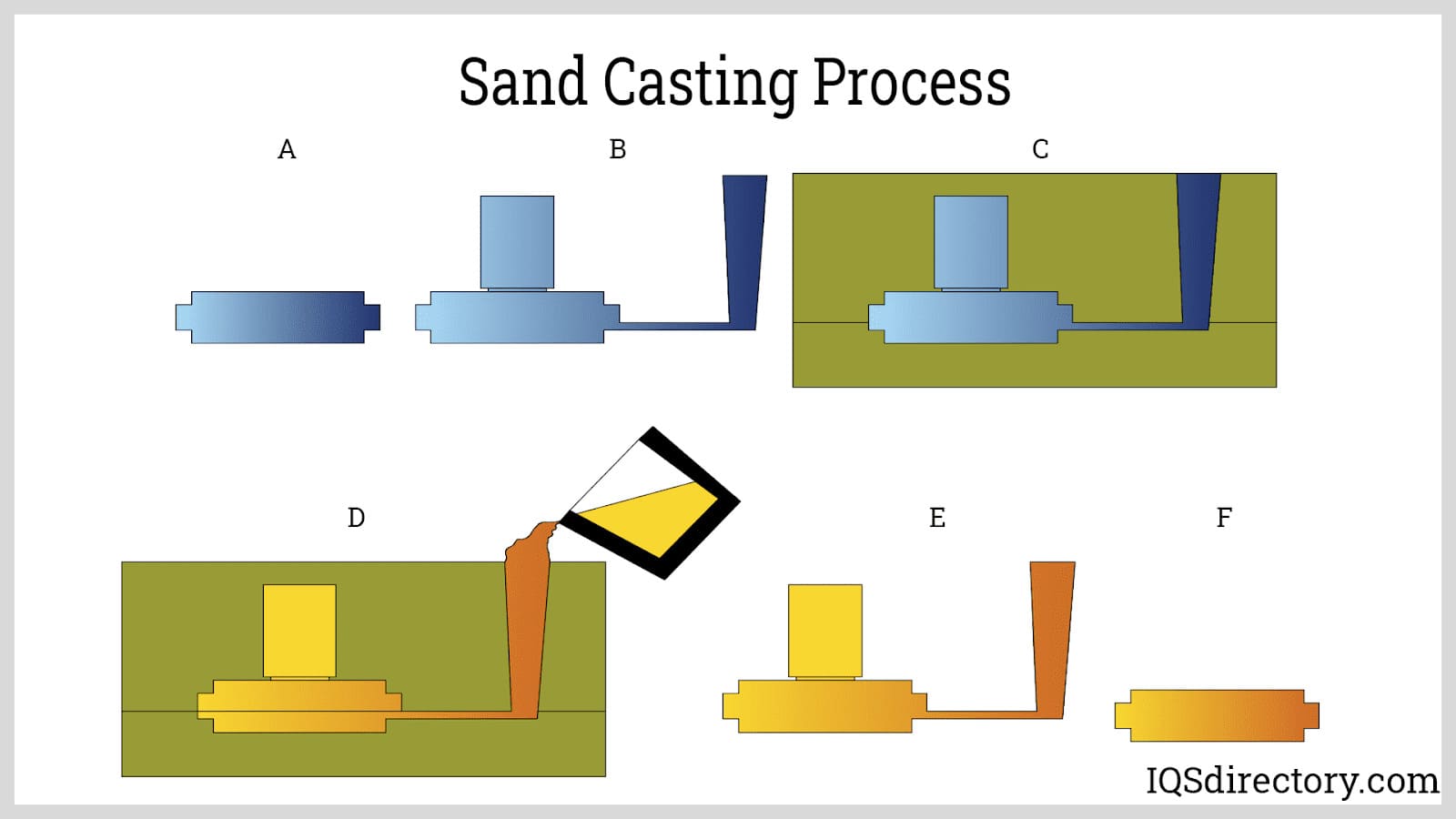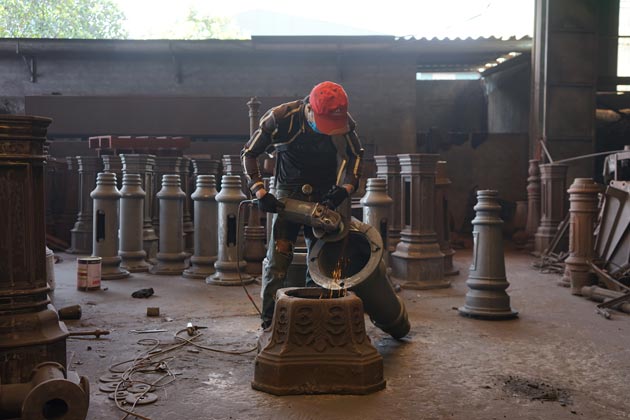How Aluminum Foundry Wisconsin strengthens casting businesses
Just How Aluminum Foundry Adds To Innovations in Aerospace Design
Aluminum foundries are important to developments in aerospace engineering. They create lightweight, high-strength elements that are vital for contemporary airplane. Via sophisticated casting strategies, these foundries create complicated geometries that improve structural stability. Additionally, the advancement of premium Aluminum alloys sustains the industry's emphasis on fuel efficiency and sustainability. Nonetheless, difficulties remain in the manufacturing procedure. Recognizing these elements exposes the profound influence of Aluminum on air travel's future.
The Significance of Lightweight Products in Aerospace Style
As the aerospace market remains to advance, the value of lightweight products comes to be progressively obvious. The demand for effectiveness and sustainability drives designers to prioritize using materials that lower total weight without endangering architectural stability. Light-weight products, particularly Aluminum, play a vital duty in improving gas performance, improving payload capacity, and increasing the overall performance of airplane.
Furthermore, the integration of these materials permits for ingenious layouts, making it possible for producers to create more wind resistant forms that can stand up to severe conditions. The reduction in weight not just decreases operational costs yet also contributes to a reduced environmental impact, lining up with global efforts toward sustainability in aeronautics.
Advanced Casting Techniques in Aluminum Foundries
Advanced spreading methods in Aluminum factories play an essential role in aerospace engineering by allowing the manufacturing of lightweight and accurate parts. Innovations in mold and mildew style and precision spreading processes are important in achieving excellent efficiency and structural honesty. Furthermore, the growth of light-weight alloys boosts the total effectiveness and efficiency of aerospace applications.
Innovative Mold And Mildew Layout
Ingenious mold layout plays a necessary role in the efficiency and performance of Aluminum shops, specifically within the aerospace field. By leveraging sophisticated products and methods, modern-day molds can be crafted to stand up to heats and pressures, guaranteeing peak efficiency throughout the casting process. These designs frequently include complex geometries that enable the manufacturing of lightweight yet structurally sound components, important for aerospace applications. In addition, using computer-aided layout (CAD) software promotes precise modeling, making it possible for foundries to replicate and improve mold and mildew designs before physical production starts. This not just boosts the quality of cast parts however also reduces waste and lead times, bring about significant expense savings. Overall, innovative mold style is a foundation of development in Aluminum Foundry modern technology for aerospace engineering.
Precision Casting Processes
The effectiveness of innovative mold designs effortlessly incorporates with accuracy spreading procedures, which are important for creating high-grade Aluminum parts in aerospace engineering. These processes, including sand spreading, die spreading, and financial investment casting, guarantee the creation of intricate geometries with limited tolerances. Advanced methods like vacuum spreading and stress die casting boost the integrity and surface area finish of the final items. Precision spreading minimizes product waste while making best use of the mechanical residential properties of Aluminum, important for aerospace applications. Furthermore, using real-time monitoring and progressed simulation tools throughout the spreading process enables instant modifications, causing enhanced quality assurance. Jointly, these accuracy casting procedures placement Aluminum factories at the forefront of aerospace development, supporting the industry's demand for dependability and performance.
Light-weight Alloy Development
As aerospace designers seek to enhance gas performance and efficiency, light-weight alloy development ends up being an important emphasis in Aluminum factories. These foundries utilize innovative casting strategies to create alloys that supply exceptional strength-to-weight ratios. Innovations in alloy structure, consisting of the consolidation of elements like lithium and magnesium, allow the manufacturing of materials that hold up against severe conditions while minimizing general airplane weight. Techniques such as die spreading and financial investment casting facilitate the accuracy manufacturing of complicated shapes, which are vital for aerospace applications. Additionally, continuous research aims to optimize these alloys for enhanced mechanical homes and increased toughness. By focusing on light-weight alloy development, Aluminum foundries considerably add to the development of aerospace design, paving the way for more reliable and sustainable aircraft designs.

Enhancing Architectural Integrity Via Aluminum Parts
Aluminum elements supply considerable advantages in boosting structural integrity within aerospace design. Their light-weight nature adds to total efficiency while maintaining strength, which is necessary for aircraft efficiency. Additionally, the stress and anxiety resistance properties of Aluminum assistance guarantee the longevity and reliability of aerospace structures under numerous functional problems.
Light-weight Product Advantages
While conventional materials typically endanger weight for toughness, utilizing Aluminum components in aerospace engineering uses substantial advantages in structural honesty. Aluminum's light-weight nature adds to general layout efficiency, enabling for more streamlined aircraft that eat less fuel, thus improving sustainability. The product's outstanding strength-to-weight proportion warranties that components maintain durability without adding unnecessary mass. This top quality cultivates enhanced performance and agility in trip, along with optimized payload capacities. Additionally, Aluminum's resistance to rust lengthens the life expectancy of aerospace structures, reducing upkeep prices and improving safety. As manufacturers progressively adopt Aluminum alloys, the aerospace industry experiences a transformative shift in the direction of more effective and reliable engineering services that focus on both performance and ecological duty.
Anxiety Resistance Residences
Numerous products have one-of-a-kind residential or commercial properties, Aluminum's outstanding stress and anxiety resistance stands out as an important aspect in improving the architectural honesty of aerospace parts. This resistance plays official statement a critical duty in making certain that airplane can hold up against numerous functional anxieties, consisting of tiredness, effect, and environmental conditions. Aluminum alloys, specifically engineered for aerospace applications, exhibit high tensile strength while maintaining light-weight qualities, making it possible for designers to create much more efficient structures - Aluminum Foundry. In addition, the capacity of Aluminum to withstand cyclic loading without significant contortion adds to the durability and reliability of aerospace components. As developments proceed in Aluminum Foundry strategies, the growth of stress-resistant Aluminum parts guarantees further renovations in efficiency, safety, and efficiency throughout the aerospace industry, strengthening Aluminum's role as a recommended material in modern-day engineering
Gas Efficiency Improvements Driven by Aluminum Innovations
As the aerospace sector seeks to improve gas effectiveness, innovative usages of Aluminum have arised as an important remedy. Aluminum's lightweight nature significantly lowers airplane weight, enabling reduced fuel consumption during flight. This reduction in navigate to this website weight is vital, as even tiny reductions can lead to significant improvements in total fuel economic situation.
Advanced Aluminum alloys, created for boosted stamina and durability, enable suppliers to develop elements that keep architectural honesty while reducing mass - Aluminum Foundry. In addition, the integration of Aluminum in airframes and engine elements facilitates boosted aerodynamics, adding to lowered drag and enhanced effectiveness
The adoption of Aluminum in aerospace not only satisfies the need for fuel-efficient design however additionally lines up with governing pressures for lower exhausts. As these advancements proceed to evolve, they play a substantial duty in setting new standards for fuel efficiency, guaranteeing that the aerospace industry can fulfill expanding financial and ecological obstacles.

The Role of Aluminum in Sustainable Aviation Practices
The raising focus on lasting aeronautics methods has positioned Aluminum as a vital material in the quest for greener aircraft design. Recognized for its lightweight residential or commercial properties, Aluminum significantly minimizes aircraft weight, resulting in reduced gas usage and discharges. Its recyclability better boosts its sustainability profile, as Aluminum can be reused indefinitely without loss of quality. This characteristic supports a round economic situation within the aeronautics sector, minimizing waste and source depletion.
Moreover, advancements in Aluminum alloys have actually enhanced their strength and rust resistance, enabling longer life span and reduced upkeep needs. These developments promote the growth of much more reliable aircraft structures, adding to general sustainability efforts. In addition, Aluminum's thermal conductivity plays a critical role in energy-efficient layouts, enhancing systems such as warm exchangers. Collectively, these features underscore Aluminum's essential role in advancing lasting aviation, straightening with global campaigns aimed at lowering the environmental influence of air travel.
Challenges Dealt With by Aluminum Foundries in Aerospace Production
While Aluminum foundries play a crucial role in aerospace manufacturing, they face considerable obstacles that can impact manufacturing efficiency and high quality. One major obstacle is the strict top quality control requirements called for in the aerospace sector. Any type of issue can compromise safety and efficiency, necessitating rigorous evaluation processes that prolong manufacturing timelines. Additionally, foundries commonly compete with fluctuating resources costs, which can influence rates and profitability. The complexity of Aluminum alloys used in aerospace applications further complicates the production procedure, as exact solutions are critical for attaining wanted mechanical residential or commercial properties. Knowledgeable labor shortages impede the capacity to preserve top quality production levels. Ultimately, environmental guidelines impose limitations on discharges and waste management, calling for foundries to purchase lasting techniques, which can be cost-prohibitive. These aspects collectively develop a landscape where Aluminum foundries must continually adapt to fulfill the advancing needs of aerospace see this site production while making certain security and conformity.
Future Trends in Aluminum Applications for Aerospace Design
With innovations in modern technology and boosting needs for effectiveness, the future of Aluminum applications in aerospace design is poised for substantial transformation. The combination of cutting-edge Aluminum alloys and compounds is expected to improve strength-to-weight ratios, bring about even more fuel-efficient aircraft styles. Furthermore, innovations in additive production methods will permit the manufacturing of complicated Aluminum structures that were previously difficult, enhancing efficiency and decreasing waste.

Lasting practices will certainly play an important function, with a growing emphasis on reusing Aluminum to reduce environmental effect. The aerospace market is most likely to embrace smarter making procedures, such as automation and expert system, guaranteeing higher high quality and precision in Aluminum components. Additionally, collaborations in between Aluminum shops and aerospace business will certainly promote r & d, leading the method for new applications that satisfy the rigid demands of modern-day aerospace design - Aluminum Foundry. On the whole, the future looks assuring for Aluminum's function in shaping the skies
Often Asked Concerns
What Are the Environmental Impacts of Aluminum Production in Aerospace?
The environmental impacts of Aluminum production in aerospace include significant power usage, greenhouse gas discharges, and habitat disturbance. Additionally, mining procedures can bring about soil degradation and water contamination, elevating problems concerning sustainability and environmental balance.
How Does Aluminum Contrast to Other Products in Aerospace Applications?
Aluminum offers a distinct combination of light-weight buildings, corrosion resistance, and cost-effectiveness contrasted to various other materials. Its high strength-to-weight proportion makes it specifically helpful for aerospace applications, improving gas performance and general performance in aircraft style.
What Qualifications Do Aluminum Foundry Workers Requirement for Aerospace Projects?
Aluminum Foundry employees require customized training in metallurgy and spreading techniques, in addition to knowledge of aerospace sector standards. Qualifications in quality assurance and safety and security protocols are likewise important to assure compliance with stringent aerospace job needs.
Are There Any Security Worry About Using Aluminum in Aerospace Engineering?
Security problems concerning Aluminum in aerospace engineering include vulnerability to stress and anxiety, corrosion, and fatigue cracks. Proper treatment and alloy selection are necessary to alleviate these dangers, ensuring architectural honesty and overall safety in aerospace applications.
How Does Aluminum Recycling Benefit the Aerospace Industry?
Aluminum reusing greatly profits the aerospace sector by reducing product prices, minimizing environmental impact, and preserving energy. This sustainable method improves the market's effectiveness while promoting the use of lightweight, high-performance components in airplane manufacturing.
Advanced casting techniques in Aluminum foundries play an essential duty in aerospace design by allowing the production of light-weight and specific components. Innovative mold and mildew design plays an essential role in the efficiency and effectiveness of Aluminum foundries, specifically within the aerospace market. As aerospace engineers seek to boost fuel performance and performance, light-weight alloy advancement becomes an important focus in Aluminum factories. Aluminum alloys, specifically crafted for aerospace applications, show high tensile stamina while maintaining lightweight qualities, enabling engineers to design a lot more efficient frameworks. Collaborations in between Aluminum foundries and aerospace firms will certainly promote study and advancement, paving the means for new applications that meet the strict requirements of contemporary aerospace engineering.